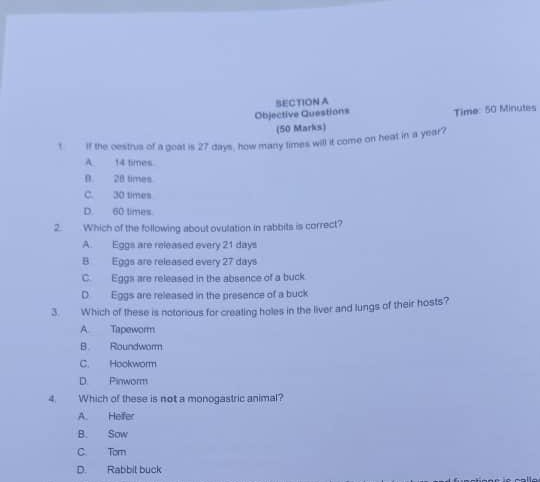NABTEB-ANIMAL-OBJ
1-10: CDCDBDAADC
11-20: CBAAACACAD
21-30: AAADBCCCCC
31-40: AAABADCACD
41-50: BCCADBACBD
COMPLETED
NABTEB ANIMAL SCIENCE
(2i)
Culling: This involves removing undesirable or unproductive birds from a poultry flock to improve efficiency, prevent disease spread, and optimize resource use (e.g., feed and water).
(2ii)
Creep feeding: This is the practice of providing supplemental feed to young animals (e.g., piglets or calves) from birth until weaning, allowing them to access feed without the mother, promoting faster growth and easier weaning.
(2iii)
Vaccination: This is the administration of a vaccine to an animal to stimulate its immune system and provide protection against specific diseases.
(2iv)
Castration: This is the surgical removal of the testicles from a male animal, typically performed to improve temperament, manage breeding, and enhance meat quality by reducing boar taint in pigs.
(2v)
Debeaking: This is the partial removal of a bird’s beak, often done in poultry to prevent feather pecking, cannibalism, and egg eating, although it can be controversial due to welfare concerns.
(2vi)
Tattooing: This is a method of permanent identification in livestock, where a unique number or mark is tattooed onto a specific part of the animal’s body (e.g., ear), serving for record-keeping and ownership verification
(2vii)
Dehorning: This is the process of removing or preventing the growth of horns in horned animals, such as cattle, to prevent injuries to other animals and handlers, and to improve handling ease.
(2viii)
Flushing: In livestock, especially sheep, flushing refers to the practice of increasing the nutritional intake of ewes before and during breeding to improve ovulation rates and increase the chances of multiple births.
(2ix)
Candling: This technique involves using a light source to examine the interior of an egg, allowing for assessment of embryo development, detection of cracks, and identification of infertile or spoiled eggs.
(2x)
Steaming up: This is the practice of increasing the feed allowance of pregnant ewes during the last few weeks of gestation to support fetal growth and prepare the ewe for lactation and lambing.
NABTEB-ANIMAL-SCI
(3a)
Pasture is land covered with grass and other low plants suitable for grazing animals, especially livestock like cattle or sheep. It is typically managed and improved for this purpose, often through practices like fertilization, irrigation, or controlled grazing.
(3b)
Rangeland is uncultivated land, primarily composed of native grasses, forbs, and shrubs, that is used for grazing by domestic livestock and wildlife. Unlike pastures, rangelands are generally not tilled, fertilized, or irrigated, and their vegetation is largely natural or semi-natural.
(3c)
(i)Uncultivated: Rangelands are not tilled or planted with crops.
(ii)Dominated by native vegetation: They primarily consist of native grasses, forbs, and shrubs adapted to the local climate and soil conditions.
(iii)Used for grazing: They provide forage for livestock and wild herbivores.
(iv)Diverse ecosystems: Rangelands support a wide variety of plant and animal species, contributing to biodiversity.
(v)Often semi-arid or arid: Many rangelands are found in regions with limited rainfall, making them unsuitable for intensive agriculture.
(3d)
(i)Livestock production: Rangelands are crucial for raising livestock, providing a natural and cost-effective source of feed.
(ii)Wildlife habitat: They offer essential habitat for numerous wildlife species, including large mammals, birds, and insects.
(iii)Water quality and quantity: Healthy rangelands play a vital role in watershed protection, influencing water quality and regulating water flow.
(iv)Biodiversity conservation: They are repositories of biodiversity, harboring a wide array of plant and animal life.
(v)Recreation and tourism: Rangelands provide opportunities for various recreational activities like hunting, hiking, and wildlife viewing, contributing to local economies.
RELATED POSTS:
NABTEB Computer Craft Studies 2025 Questions And Answers
NABTEB Physics 2025 Questions And Answers
NABTEB Economics 2025 Questions And Answers
NABTEB Government 2025 Questions And Answers
NABTEB Chemistry 2025 Questions And Answers
NABTEB-ANIMAL-SCI
(4a)
(i)In-breeding: The mating of closely related individuals within the same breed, aiming to increase homozygosity and fix desirable traits, but also increasing the risk of expressing deleterious recessive genes.
(ii)Line breeding: A form of in-breeding that involves concentrating the genes of a specific desirable ancestor in the pedigree, typically by mating related individuals that are less closely related than in strict in-breeding.
(iii)Cross breeding: The mating of individuals from different breeds or lines to combine desirable traits from both and often to achieve heterosis (hybrid vigor).
(iv)Heterosis (Hybrid Vigor): The phenomenon where the offspring of a cross between two genetically distinct individuals or breeds exhibit superior performance (e.g., growth rate, fertility) compared to the average of their parents.
(v)In-breeding depression: The reduction in fitness and performance (e.g., fertility, viability, growth) that can occur in a population due to increased homozygosity resulting from in-breeding, leading to the expression of harmful recessive alleles.
(4b)
(i)Artificial Vagina (AV) method: This is the most common and preferred method. A bull is trained to mount a phantom or a teaser animal, and an artificial vagina, which mimics the natural vagina in terms of temperature and pressure, is used to collect the ejaculate. The AV consists of a rigid outer casing, a rubber liner, and a collection cone and tube.
(ii)Electroejaculation: This method is used when a bull cannot or will not mount for semen collection. A probe is inserted into the rectum and delivers mild electrical impulses to stimulate the nerves that control ejaculation, resulting in semen collection.
(iii)Massage Method: This method involves manual massage of the accessory sex glands (ampullae, seminal vesicles, prostate) through the rectum to stimulate ejaculation. It’s often used for bulls that are difficult to train for the AV or when electroejaculation is not feasible.
NABTEB-ANIMAL-SCI
(7a)
Incubation is the process of providing optimal environmental conditions, such as controlled temperature, humidity, and ventilation, for the development of embryos, typically in eggs, until they hatch.
(7b)
(i)Counter:
To keep track of the number of eggs or the number of days of incubation.
(ii)Thermostat:
To regulate and maintain a constant temperature within the incubator.
(iii)Hygrometer:
To measure and monitor the humidity levels inside the incubator.
(iv)Egg tray:
To hold the eggs securely and allow for easy turning (if applicable).
(v)Heater:
To provide the necessary warmth to maintain the optimal temperature for embryo development.
(7c)
(i)Protection from adverse weather conditions: Housing protects livestock from extreme temperatures (heat or cold), rain, wind, and direct sunlight.
(ii)Disease prevention and control: Proper housing facilitates hygiene and sanitation, reducing the risk of disease transmission and making it easier to manage outbreaks.
(iii)Protection from predators and theft: Secure housing keeps livestock safe from wild animals and prevents theft.
(iv)Improved management and productivity: Suitable housing allows for better feeding, watering, breeding, and overall management, leading to improved health, growth, and productivity of the animals.
COMPLETED

Mr. Femi is an education blogger who simplifies exam updates and study tips for Nigerian students. His goal is to make learning smart, easy, and rewarding.


1 thought on “NABTEB Animal Science 2025 Questions And Answers”